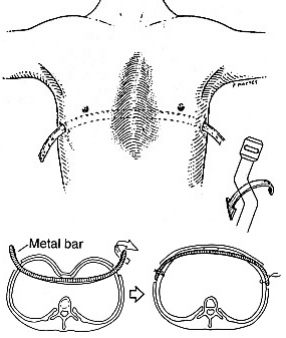
The Nuss Procedure is a minimally invasive procedure invented in 1987 by Dr. Donald Nuss for treating Pectus Excavatum. He developed it at the Children's Hospital of the King's Daughters in Norfolk, Virginia. Dr. Barry LoSasso spent extensive time working with world-renowned Dr. Nuss before focusing his practice and receiving the designation of a Center of Excellence for Pectus.
The bar placement operation typically takes approximately six hours. Through two small incisions in the side of the chest, an introducer is pushed along posterior to the sternum and ribs, and anterior to the heart and lungs. Then, a concave stainless steel bar is slipped under the sternum through the incisions in the side of the chest. A third, smaller incision is made to insert a thoracoscope (a small camera) to help guide the bar. Taller patients, older patients, or patients requiring extensive correction may receive two or more bars. All bars may be placed through two incisions, or additional incisions may be made. The bar is then flipped, and the sternum pops out. To support the bar and keep it in place, a metal plate called a stabilizer may be inserted with the bar on one side of the torso. PDS sutures (a synthetic, absorbable, monofilament suture made from a polymer of paradioxanone) may also be used in addition to the stabilizer. The stabilizer fits around the bar and into the ribcage. The bar and stabilizer are secured with sutures that dissolve in about six months.
What is the Nuss Procedure?
Pediatric Nuss Procedure
Dr. LoSasso has performed over 1,500 Nuss Procedures on children and young adults. The optimal age for the Nuss Procedure is 13-15 years old. Although some patients show signs of a sunken chest as early as birth, as a child grows, the chest will continue to malform, creating a more pronounced sunken effect, which can ultimately affect the heart and lungs. While Pectus Excavatum is not a life-threatening disorder, the effects can significantly affect a patient’s quality of life. Children around 10-15 years old may start to notice signs of Pectus Excavatum affecting their athletic ability, causing shortness of breath and leading to reduced athletic stamina compared to their peers.
Adult Nuss Procedure
Dr. LoSasso is one of the few surgeons in the U.S. who is not only a skilled pediatric surgeon but also performs the Nuss Procedure on adults. Many of the adult patients Dr. LoSasso now sees either did not have access to surgery when they were younger or decided not to proceed for whatever reason. The procedure remains highly effective in adult patients.
Historically, the Nuss Procedure has been less standard as an option for Pectus Excavatum surgery in adults because fully developed chests are less pliable. In 2014, the University of Pennsylvania’s Perelman School of Medicine published a review of a long list of studies on pectus excavatum surgery. The study concluded that although the Nuss procedure is more straightforward in younger patients, it appears safe and effective in adults in the short term, at least. Per the NCBI (National Center for Biotechnology Innovation), “In our opinion, patients older than 20 years with a moderate-to-severe pectus excavatum should be scheduled for a Nuss procedure as the first option to correct chest deformity.”
Removing the Nuss Bars
Bar removal as the final stage of the Nuss procedure for pectus excavatum repair is generally straightforward. Patients can expect the bar(s) to be removed at least 3 years after placement. The factors contributing to the length of time the bar(s) will remain in place will be determined by the age of the patient, the sex of the patient, the rate at which the patient is growing (if an adolescent), and by the severity of which the chest is sunken. The recovery and physical therapy after the bar is removed can be lengthy, and the patient must also be mature enough to participate in the prescribed exercises. The pain after removal is much less than during the original insertion.
The removal is an outpatient procedure performed under general anesthesia, so the patient goes home the same day. The removal usually takes between 2 and 4 hours.
Please note, we feel it is very important that the same surgeon who places the bar(s) originally should be the same surgeon who removes the bar(s) if at all possible. The continuum of care reduces risk because each surgeon has a specific process they use uniquely when performing the Nuss Procedure.
Metal Bar Placement
Webinar Recording: Removing the Pectus Excavatum Bars
Dr. LoSasso and his team are truly amazing. We are so grateful for their caring demeanor, professional care and friendly atmosphere at their practice.
— Michael

